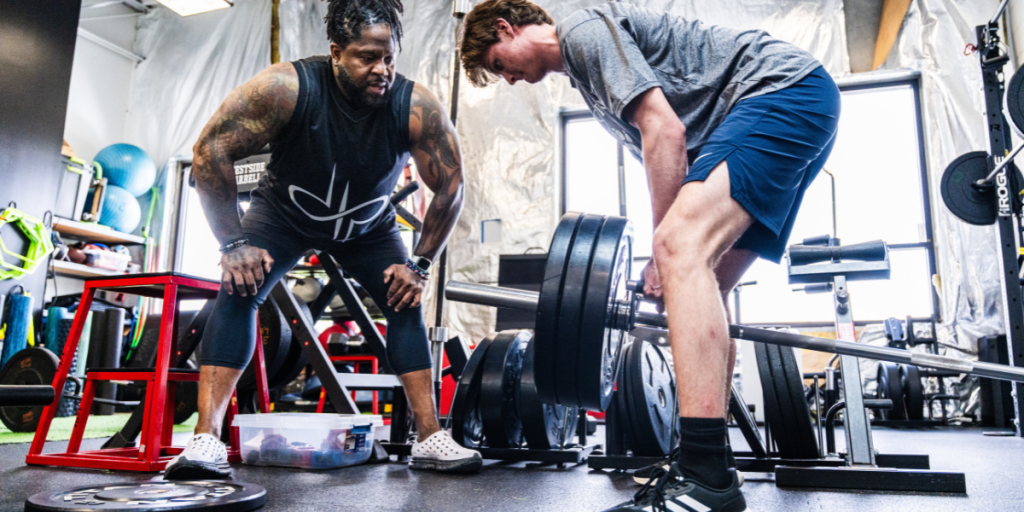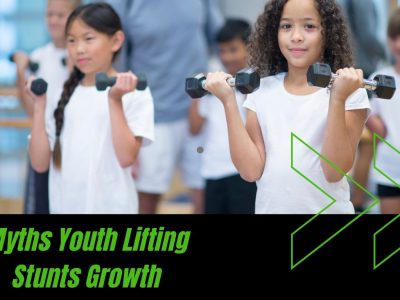Does weightlifting stunt growth in children and teens?
As personal trainers and athletic performance coaches, we often get this question. The myth that youth lifting stunts growth is widespread but false. In this article, the team at Infinite Performance Training will debunk this myth with scientific evidence and highlight the benefits of strength training for young athletes.
Quick Takeaways
Here are some highlights of weight and resistance training for youth and the common misconception of stunting growth:
- Research indicates that weightlifting does not stunt growth in children and adolescents, and health professionals endorse supervised strength training for its numerous benefits.
- Growth plate vulnerabilities highlight the importance of safe and controlled strength training, which, when properly executed, poses less injury risk than high-impact sports.
- Strength training for youth provides significant physical and mental health benefits, including improved bone density, increased confidence, and better injury recovery.
Myth: Lifting Weights Stunts Growth

The myth that lifting weights stunts growth is widespread and deeply ingrained in the minds of many. Think about your childhood; how often did you hear someone say to wait until you were a certain age before training or lifting?
This belief suggests that weight training during childhood and adolescence could somehow impair growth and development, which intimidates parents from letting their student-athletes train. However, research shows that this fear is unfounded. Studies have consistently demonstrated that strength training does not harm growth in children and teens.
The American Academy of Pediatrics has concluded that structured strength training programs do not negatively impact a child’s growth. When properly designed and supervised, lifting programs can be highly beneficial. Clarifying this myth is crucial as it prevents children from accessing the numerous health benefits and developmental opportunities of strength training.
Dispelling this misconception allows children to safely engage in strength training, gaining benefits like increased muscular strength, improved bone density, and overall fitness. The real risk lies not in the training but in the misinformation that keeps children away from these valuable activities.
How Growth Plates Work in Youth Athletes
A lot of the negativity around lifting young stems from the misconception of injuring growth plates.
Growth plates are essential areas in the body for developing cartilage. Growth plates, found at the ends of long bones, play a crucial role in a child’s linear growth, gradually ossifying and turning into solid bone as the child matures. These plates typically close during late adolescence or early adulthood, marking the end of bone elongation.
Understanding the function and vulnerabilities of growth plates helps clarify why the myth of weightlifting stunt growth persists. Growth plate injuries can result in limited stature, but such injuries are more commonly caused by high-impact sports like football and gymnastics rather than controlled strength training. Under professional supervision, adequately executed weight training does not harm adolescents’ growth plates.
Thus, the key to protecting growth plates is ensuring that young athletes engage in safe, well-supervised strength training programs. This approach safeguards their growth and improves their overall physical development and injury prevention.
Scientific Evidence Against Stunted Growth
To put it bluntly, there is ZERO scientific research that supports the claim that weightlifting stunts growth in children and teens. Longitudinal studies have consistently not found any causal link between weightlifting and reduced height. There is no evidence to support this claim. Comprehensive studies have shown that weight training has no adverse effects on height or overall growth.
Experts from various health fields, including the American Academy of Pediatrics and the National Strength and Conditioning Association, agree on the safety and benefits of resistance training for youth. They endorse supervised strength training as a safe and effective way to enhance muscular strength, bone density, and overall fitness in children and adolescents.
Interestingly, the risk of injury from typical childhood activities often exceeds that associated with weightlifting. By following proper training protocols and ensuring professional supervision, young athletes can safely enjoy the benefits of strength training without any fear of stunted growth.
Physical Benefits of Strength Training for Youth

Engaging in a properly designed weight training program can significantly enhance bone density in youth athletes. Studies have shown that young weightlifters often achieve greater bone density than their non-lifting peers, which is crucial for their development. Girls, in particular, benefit greatly from strength training as it contributes to enhanced bone density, reducing the risk of osteoporosis later in life.
Here are the countless benefits of performing regular resistance training even as a child:
- Bone health
- Lean body mass,
- Reduces fat, and improves muscle development,
- Coordination and functional movement improvement
- Better mental health and confidence
- More muscle mass and a better body composition
- Helps instill discipline and focus
These improvements contribute to better athletic performance and overall fitness. Regular strength training can also lead to quicker recovery from injuries, making it an essential component of physical therapy for young athletes.
Moreover, strength training can significantly reduce the risk of sports-related injuries. By enhancing overall muscular strength and stability, young athletes become more resilient and less prone to injuries during their sporting activities. Qualified professionals can design resistance training programs tailored to meet the needs of different ages and skill levels, ensuring that each child benefits safely and effectively.
One huge upside to weight training on youth sports, kids, and athletes is the mental well being that comes from working out!
Mental Health Benefits of Weight Training
The mental health benefits of weight training for youth are profound. We all are aware of the epidemic of mental health issues due to too much technology use, cell phones, and social media among adolescents.
Engaging in strength training activities can significantly boost a child’s confidence, positively impacting them in the long term. Within weeks of starting a strength training program, young athletes often experience increased stamina and self-confidence, which can translate into other areas of their lives.
Regular strength training has been associated with decreased symptoms of depression, particularly in mild cases. It is increasingly being utilized in the treatment and management of mental health conditions, offering a natural and effective way to improve mental well-being. Enhanced sleep quality is another benefit, contributing to better overall mental health.
Additionally, lifting weights helps balance hormone levels, including dopamine, norepinephrine, and serotonin, which are crucial for mood regulation. Keeping a workout log can also motivate teens by allowing them to track their progress and feel a sense of accomplishment. These mental health benefits make strength training a valuable tool for overall youth development.
Proper Lifting Technique and Safety Guidelines
Proper technique and safety are paramount in strength training for youth. Ensuring correct form and technique can mitigate the risks associated with strength training. Dynamic stretching is recommended for warming up before strength training sessions, helping to prepare the muscles and joints for the exercises ahead.
At Infinite Performance Training, we have a multiple-step process for acclimating youth and athletes to lifting and training:
- Bodyweight exercises are crucial for perfecting form before adding resistance.
- We begin strength training should begin with basic exercises that emphasize proper movement patterns.
- We avoid maximal lifts for teens, as these increase the risk of severe injuries. Once they have great form, we incorporate heavier strength training options.
- Of course, as with all training, proper warm-up, cool-down, and weight-lifting techniques are essential to prevent injuries.
Listening to one’s body is another critical aspect of safe training. Young lifters should stop exercising if they experience pain and should not lift the same muscle group two days to allow muscles time to recover and grow stronger. We also use FITT principles and take the frequency of training very seriously. Rest days are vital for muscle recovery and overall progress, so we focus on recovery as much as training.
Role of Supervision and Professional Guidance

Supervision by qualified adults is essential during strength training sessions to prevent injuries. Proper oversight by qualified professionals significantly reduces the risk of injury during youth weight training. Injury rates among youth athletes are notably low when trained coaches ensure proper technique and fatigue management.
Proper form and technique minimize the likelihood of injuries. An appropriate coach-to-athlete ratio, such as one coach for every ten young athletes, is recommended for safe training.
Experts agree that resistance training for adolescents is safe and beneficial when supervised and performed with proper techniques. Supporting, rather than prohibiting, youth engagement in weightlifting activities is crucial for their secure development.
Success Stories of Young Athletes
Success stories of young athletes highlight the value and safety of appropriately performed resistance training. Michael Phelps, for example, started resistance training at the age of seven and went on to become one of the most excellent swimmers of all time. Here at Infinite Performance Training of Gainesville, VA, we have multiple student-athlete stories where strength training has led to positive gains:
Real-life examples reinforce the idea that resistance training can be beneficial without hindering growth. These success stories serve as powerful testimonials, reassuring parents and coaches that with the right guidance and supervision, young athletes can thrive in their chosen sports.
Tips for Parents and Coaches
Parents and coaches ensure young athletes’ safe and effective strength training. At Infinite Performance Training, we provide strength training tips and teach how they can be performed safely in various environments, not just traditional weight rooms. Incorporating warm-up and cool-down periods into training routines is essential to prevent injuries and enhance performance.
Emphasizing proper technique is more important than too much weight lifted for young athletes. Strengthening programs should include a variety of exercises targeting all major muscle groups. Creating a supportive and encouraging environment is vital for the child’s growth and development.
The Verdict –
Can youth lift negatively impact growth? The answer is when done correctly and supervised, no. Just like in anything, kids who use proper form will be ok. However, anyone can get hurt performing any athletic movement and that includes lifting weights.
When appropriate guidelines are followed, the physical and mental health benefits far outweigh the risks. In fact, by embracing strength training, young athletes can achieve greater bone density, improved muscle strength, and enhanced overall fitness. Parents, you should feel reassured by the success stories and expert recommendations, knowing that a well-structured and supervised strength training program can contribute positively to a child’s development.
For a free consultation, please feel free to reach out to Infinite Performance Training here:
GET IN TOUCH
Schedule a Training Session
Frequently Asked Questions
1. Does lifting stunt growth?
Lifting weights does not stunt growth in children; in fact, research indicates that well-structured and supervised strength training programs are both safe and beneficial for their development. Ensuring proper guidance is key to maximizing the advantages of weight training in young individuals.
2. What are growth plates, and how do they relate to weightlifting?
Growth plates are areas of cartilage at the ends of long bones essential for growth in children. Properly supervised weightlifting does not harm these growth plates and can be safe for developing individuals.
3. What are the physical benefits of strength training for youth?
Strength training for youth improves bone density, muscular strength, coordination, and overall fitness, while also aiding in injury prevention and recovery. These benefits contribute significantly to their physical health and development.
4. How does weightlifting benefit a child’s mental health?
Weightlifting significantly benefits a child’s mental health by boosting confidence, alleviating symptoms of depression, and enhancing sleep quality. This multifaceted approach to fitness contributes to a healthier emotional and psychological state.
5. What safety guidelines should be followed for youth strength training?
To ensure safety in youth strength training, it is crucial to emphasize proper technique, begin with bodyweight exercises, avoid maximal lifts, provide adequate supervision, and incorporate rest days for recovery. Following these guidelines will promote a safe and effective training environment.


 Weight Loss Near Me: Gainesville, VA Weight Loss Pros
Weight Loss Near Me: Gainesville, VA Weight Loss Pros
Leave a Reply